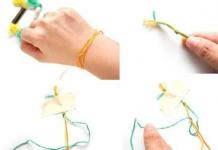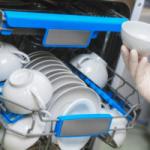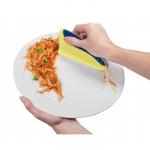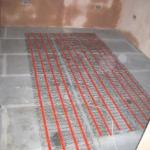Our review focuses on how to properly load dishes in the dishwasher.
The quality of washing depends not only on the reliability of equipment, a reasonably selected detergent and timely poured salt. How well the dishes will be washed also depends on their location in the bunker.
Preparing to download
Before placing plates on the shelves and compartments of the PMM, clean them of food debris. The better you do this, the higher the chance of avoiding clogged filters and drains.
On a note! Use paper towels or napkins, a damp sponge, or a rubber spatula, whichever is more convenient, to brush food off the plates. Make sure that there are no egg shells, fruit pits, grains left - these are the enemies of the drain system and provocateurs of blockages.

Do not know whether to rinse the plates before loading into the PMM? After rinsing, the washing quality improves. But the owners of the equipment are justifiably wondering why they need a machine if they need to be washed by hand. Therefore, there are models with the "Soak" or "Pre-wash" function. If there is no such option, you will have to soak the plates.
How to arrange cups, glasses and glasses
Glasses, mugs, cups and glasses need to get rid of tea, coffee, wine and other deposits. For fragile containers, a separate tray is provided, located on top of the hopper. Put them ONLY upside down - so the water will get inside and then drain down. Do not stack glasses or mugs (porcelain, crystal, glass) in a horizontal position, otherwise the washing effect will be zero.

Is it possible to put glasses close together so that they touch? Definitely not: wine glasses and glasses need to be fixed with a special mount - a holder. Without it, fragile products, even on a delicate program, can burst or break. Wine glass holders can also be used for small cups.

On a note! When sliding the tray, check how securely everything is fixed and arranged. Use fasteners and other accessories as needed.
How to arrange plates according to the rules
Depending on the size of the plates and their purpose, they can be placed in one of the trays - from above or below. If the volumes of your Bosch, Hansa, Electrolux dishwasher allow, you can place everything: bowls, gravy boats, salt shakers, etc.

When choosing a low-temperature mode, load plastic dishes on the top shelf - plates, trays, containers. So the “delicate” utensils will be away from the heating element, and the plastic will not melt.
The lower tray is used to load large and medium plates, including soup dishes. Place the widest plates on the edge, with a smaller diameter - closer to the center. This will ensure 100% water access to the very top of the bunker.

Place the dishes with the front part to the center of the basket, making sure that there are gaps. The greater the distance, the more efficient the washing process.

Important! Do not load "to the eyeballs" compact machine! If you manage to "shove" more than 5-6 declared sets, all this simply will not be washed off.
Cutlery: fold correctly
To load cutlery into the machine, find a small tray or basket inside the hopper. When laying out spoons and forks, alternate them so that they do not join together. Blades of knives should be directed strictly down.

In the latest PMM models, such as Bosch or Siemens, a top tray is allocated for cutlery. In such a compartment, spoons need to be laid out horizontally: the appliances are washed efficiently, and the space in the bunker is saved. In addition, the location of sharp instruments - knives and forks - in a horizontal position is the most successful in terms of safety.

Important! Do not load sharp and ceramic knives into the PMM. So you risk dulling the blades. This also applies to knives and utensils with a wooden handle (any wooden utensils cannot be washed in a typewriter).
Arrangement of large dishes
Large kitchen utensils in which food is cooked (pans, pots, saucepans, baking sheets, etc.) should be placed in the lowest basket. Wash them separately from glass, porcelain and crystal items: pots and pans require intensive washing, which fragile appliances will not endure.
Frying pans and baking sheets
Put them sideways. Place pots upside down or at a slight angle to allow water to flow all over the hopper. If the pans are turned upside down, water will not get into the upper tray, so follow the rules.


On a note! Is it possible to wash the pan in PMM (with a Teflon or other coating), the manufacturer indicates. If the permission icon is not found, do not risk it. Read about what can not be washed in the dishwasher, in a separate publication.
If there is a removable handle, disconnect it immediately. Place frying pans, ladles and stewpans with a handle especially carefully, without touching the walls of the tank or adjacent plates with it. If you see that the dishes clearly do not enter the hopper, wash them in parts. Use half load mode, if it is provided in the functionality of your PMM.
When placing baking sheets, try to place them sideways along the edges of the tray. If there is no special holder nozzle, follow the general location rules so that the sprinkler does not interfere with the water supply.

Small utensils: is it possible to wash and how
If you really want to wash a cutting board, a ladle, a slotted spoon or a spatula in a typewriter, this can be done - provided there are no wooden parts. Plastic spatulas, salad spoons, tongs, ice cream spoons, etc. are not recommended to be sent to the machine (or put only on the very top, as we wrote above). Place all this together with forks and spoons in a basket or tray.

Important! Position appliances only in a horizontal plane, even if they are not provided with special boxes or they do not fit in them.
The capacity of the machine is indicated by the concept of " set of dishes». It usually includes a set that one person needs for a one-time meal. At first glance, everything is simple. But machine manufacturers have standardized concepts about plates, cups, cutlery. Diversity reigns in our kitchens - and often plates, cups and even spoons and forks are far from European standards.
The actual capacity of the PMM for 17 sets is 13-14. And given the need to wash pots and pans - even less.

To ensure that the optimal amount of dishes enters the hopper and it is well washed, follow the recommendations:
- do not try to fill the dishwasher to capacity, leave gaps;
- look for icons that allow the item to be sent to PMM;
- place large utensils away from fragile ones (pots away from glasses, etc.);
- do not wash wood;
- put dirty dishes directly into the hopper - there they will not dry out and will be easier to clean.
As you can see, the rules and recommendations for the arrangement of dishes are not so complicated. A couple of workouts - and you will learn how to quickly and correctly arrange everything: from glasses and saucers to baking sheets and pans. If our review was useful to you, mark it in the comments.
Finally, we suggest watching the video:
Do you know how to properly load dishes into the dishwasher (hereinafter referred to as the dishwasher, PMM)? Those who have just bought this household appliance are probably not yet familiar with this process. You must immediately learn: the quality of their washing depends on the correct placement of knives, spoons, forks, cups, glasses, plates, pots and pans inside the machine. If you fold kitchen utensils in any way, you will not wait for clean dishes.
Despite the fact that most modern models of Bosch, Siemens, Electrolux, Zanussi and other brands have pre-rinse and soak programs, do not count on the fact that the PMM will wash away all the dried food residues from the dishes. Before putting the utensils in the dishwasher, you will have to clean the dried food from its surface with a spatula or spoon. But if you use the technique immediately after eating, you don’t have to do this.

Restrictions for some materials
The specifics of the operation of modern dishwashers imposes serious restrictions on washing utensils made from certain materials. This is due to factors such as:
- large temperature fluctuations in a short period of time;
- long-term treatment with hot water mixed with steam;
- the use of aggressive detergents that can damage the surface.

For the above reasons, manufacturers do not advise washing utensils made from such materials:
- Tree- from prolonged contact with hot water, the wood swells and cracks, even despite the presence of a protective coating.
- Plastic- does not tolerate high temperatures and can be deformed from such exposure.
- Silver, tin, aluminum and copper- in a hot humid atmosphere, oxidative processes on the surface of the listed metals are sharply activated. As a result, the color of the dishes changes to darker, it is covered with a film of oxides.
- Cast iron- after the aggressive effects of household chemicals, there is a possibility of rust on the metal surface.
- Teflon coating- used to form a non-stick layer in frying pans, stewpans and pots. Under the influence of detergents, it is gradually washed off from the surface.

It turns out that knives can become dull if they are washed in a PMM. And if you put kitchen items with decorative painting in the trays, after the next intensive washing you may not see the drawings - there is a chance that household chemicals will wash them away.
If you want to know in more detail what utensils should not be washed in the dishwasher, watch this video:
The main rules to be observed when loading dishes
An important condition for the long-term and proper operation of dishwashers is compliance with the rules that are prescribed by the manufacturer in the instructions. Among them is the pre-treatment of dishes before laying in the PMM, that is, cleaning its surface from the remnants of solid and dried food. For this purpose, you can use soft spatulas, napkins, sponges. If the device does not have a soaking function, this operation must be performed manually as necessary.

How to arrange glasses, goblets, mugs and cups
If it takes a long time to put the dishes in the dishwasher for the first time, don't worry. As they say, the first pancake is lumpy. But in the future, a full load will take no more than 8-10 minutes.
In most cases, glasses, wine glasses, goblets, mugs and cups are placed upside down in the upper basket. This position makes it possible to wash and rinse the inner surface, while the liquid will flow down freely (see photo).

Glasses with thin walls should be placed at close intervals, otherwise there is a chance that fragile glass or crystal will break.
How are the plates stacked?
This type of kitchen utensils has different sizes. Arrange dishes in the dishwasher in this way: small saucers, bowls, gravy boats and plates for dessert can be placed in the upper basket. Larger plates are placed in the bottom tray. In this case, dishes with the largest diameter should be laid out closer to the edges, and smaller plates closer to the center. This will ensure better penetration of the detergent onto their surface.

The front of the plates should be facing the center. At the same time, gaps must be left between objects so that the liquid penetrates well for cleaning and is washed off when rinsing. It is important not to overfill the dishwasher, the quality of the wash depends on it. The number of loadable sets of dishes depends on the dimensions of the cooking chamber.
Loading cutlery
In new models of Bosch, Siemens and other dishwashers, knives, forks and spoons are provided with narrow trays located at the top of the chamber. In this case, all cutlery is laid out horizontally. Knives should be directed with the pointed part down.

In older models of equipment, small baskets are provided in which knives, forks and spoons should be washed in an upright position. Knives are handled up, and spoons and forks are down (see photo).

What is the best way to arrange large kitchen utensils
Dishes such as pots, pans and baking sheets are washed in the lower tray. But they are located differently. For example, shallow pans and baking sheets should be at the bottom, in an upright position. Small items can be placed at the top if they fit (see photo). Saucepans and pans with deep sides are best placed at a slight angle so that the liquid penetrates better and enters the upper basket.

It is best to place baking sheets on the edges of the tray so that they are closer to the walls of the chamber. In the case of pans, you need to experimentally determine how best to wash them - in a strictly vertical position or at a slight angle. Pots are best placed in the bottom basket upside down. At the same time, do not load dishes into the upper tray, and run the PMM in half load mode.

Be careful with pans that have a Teflon coating. To make sure that they can be washed, read the instructions for the machine and the symbols on the dishes. If the saucepan or frying pan has a removable handle, it is better to wash them separately. Place items with non-removable long handles especially carefully so that the handles do not interfere with the cleaning of adjacent dishes.

If you want to wash small utensils, it is best to place them where there is a place for cutlery. At the same time, do not forget one important rule: for wooden objects and accessories, the path to the dishwasher is closed.
Finally, we recall a few important rules that you must always remember:
- Each manufacturer understands the load level of the dishwasher in its own way. After all, the concept of "utensil set" in each country may be different. Under such a set is meant the amount of dishes that one person needs for eating. If the manufacturer writes that the PMM holds 17 sets, place no more than 12-13, then you will not lose.
- Always leave space between adjacent objects.
- Try to wash the dishes immediately after eating so that the dirt on them does not dry out. This saves time and wasted detergent.
- Do not place heavy metal products and fragile glass objects nearby.

If you follow all the above rules and follow the instructions, the dishwasher filling procedure will take very little time. Remember: each manufacturer has its own recommendations for the location of utensils, depending on the location and number of spray arms.
Video
We suggest watching a video to know how to arrange sets of dishes in baskets and trays of a Bosch dishwasher:
Electronic engineer with many years of experience. For several years he was engaged in organizing the repair of household appliances, including washing machines. She loves sport fishing, water tourism and traveling.
Found an error? Select it and press the buttons:
Ctrl+Enter4.8 Rating 4.8 (5 votes)
If a dishwasher has started up in the house, disputes about who does the dishes should be settled. But along with the new assistant come new responsibilities. Its owners will not only have to take care of its cleanliness and serviceability, but also properly arrange plates, cups and cutlery in it. Let's figure out how to load dishes into the dishwasher (PMM).
Wash preparation
The first load takes 20 minutes for users who do not have experience with a dishwasher. Having gained dexterity, dishwasher owners cope with the task of loading a standard batch twice as fast in 10 minutes.
Before placing the plates in the baskets, they are cleaned of food debris, otherwise they will then have to be removed from the filters, hoses and nozzles. It is better to remove food in advance than to disassemble and clean problem nodes. It is convenient to do this with napkins, sponges, a rubber spatula. Solid food must not fall into the hopper.
Pre-rinse
Do I need to rinse my dishes before putting them in the dishwasher? Thanks to rinsing, any utensils are better washed. But then the question arises: why spend money on PMM if you have to remove half-eaten food, properly lay out the plates, and even pre-rinse it? If you load the plates immediately after eating, then you don’t have to do anything, they will be perfectly washed. But if the food is dry, then the plates and bowls should be rinsed before loading into the hopper.

How to put mugs and glasses?
Let's start the arrangement with cups, mugs and glasses. They are placed in the upper container, upside down, the water will wash them from the inside. If you put them on their side, horizontally, they will not be washed off, water from the sprayers will not get inside them.

There are special holders for glasses. Wine glasses are placed with the foot up. The bunker is cramped, and users are wondering if it is possible for the glasses to touch? It is forbidden. When washing, glass can break due to micro-collisions of neighboring wine glasses. In addition to glasses, the plastic holder will comfortably accommodate coffee cups.
The “seat” for cymbals is determined according to size and shape. It is better to put small items in the upper basket; it will fit for bowls, gravy boats, salt shakers, bowls, dessert plates, bowls and saucers.

If the washing is carried out with a slight heating of the water, it is allowed to place plastic products at the top, they are placed at a distance from the heater in order to avoid deformation of the material.
The bottom basket is filled with soup bowls. Large ones are placed around the edges. Smaller in the center. This is done to ensure water access to the top tray. The plates are placed facing the center point of the chamber, so that adjacent bowls do not touch. A large gap between the "neighbors" provides high-quality washing - this is the main principle of proper loading.
Placement of cutlery
Knives, forks and spoons of all types and sizes, united by the concept of "cutlery", are placed in a separate basket. Arrange them freely, trying not to place the same devices side by side. With a dense staffing, the spoons and forks will not be washed off. The location of the knives is strictly down with the blade.

New PMM models from the brands Bosch and Siemens ("Siemens") are equipped with a special tray for spoons and forks. It is located at the top. The devices are placed in it in a horizontal position, which is economical, safe and provides high-quality washing.
How to place large dishes?
Trays, frying pans, saucepans, etc. placed in the bottom container. For her, it is recommended to arrange a separate wash without glass, porcelain and crystal products. It is better to wash them in intensive mode, in hot water. Frying pans and baking sheets are placed on their sides, pans are turned upside down, or placed obliquely. Thanks to a reasonable arrangement, water jets will reach each product, there will be no obstacles for access to the top.

Removable pan handles are removed. It is impossible that they touch the walls of the chamber. When placing large dishes in the lower tray, the main thing is not to turn it upside down, otherwise water will not get up. If you still decide to put the pans in this way, then do not put anything on top and use the "half load" mode. This will save you water and electricity. Placing trays on the sides of the lower basket.
What about kitchen utensils?
What about ladles, skimmers, cutting boards? They are machine washable as long as they are not made of wood or plastic. Plastic gizmos can be put on top, boards on the sides of one of the trays. Cutting boards are best washed by hand. Ladles and skimmers are placed horizontally.

How much is placed?
How many pots, plates and spoons can be washed at a time? Read the instructions for capacity. Unit of measure kits. In small-sized PMM, 6 sets are washed per cycle, in narrow ones no more than 11, in full-sized no more than 17.

A set is a set of dishes necessary for one person. What is included in the kit, the manufacturer knows. Approximate set of a pair of plates, cutlery, a cup. In fact, the machine holds about 12-14 sets. If you need to wash an additional couple of pots and pans, then less.
- Do not stuff a lot of dishes at once, leave space between adjacent objects.
- Before loading the product into the chamber, look for signs on it that allow or prohibit washing in dishwashers.
- Keep large items, such as frying pans, away from fragile items.
- Do not load wood products.
- Dirty plates should be immediately sent to the chamber, then the food on them will not dry out, and they will be easily washed.
Do not rush to immediately load all the dirty dishes into it. The quality of washing and the service life of the equipment directly depend on how correctly this is done. Dishwashers are designed to make life easier. But do not count on the fact that they will completely free you from manual work. Certain types of kitchen utensils and items are not suitable for washing in a dishwasher. In addition, the dishes must be able to properly place in the mechanism.
For more information on how to properly load dishes into a dishwasher (PMM) and how to properly operate kitchen appliances, read the article.
Preliminary preparation of PMM
Before you start loading the dishes and press the "Start" button, do not forget to pour salt for PMM into the compartment intended for this. Do this about once a month. Regardless of the chosen detergent (“3 in 1”, “7 in 1”, etc.), we do not recommend neglecting salt. Appliances will last longer and dishes will be cleaner.
The same goes for rinse aid. Despite the use of multifunctional detergents, the rinse gel will add shine to clean dishes and will not leave powder streaks on them.
Periodically inspect machine filters and clean or replace if required. First of all, clean the filter located on the pipe connected to the water supply.
Check the tightness of the hose connection. Make sure the sprinklers are clean and free to rotate. The holes are often clogged with food if it is not removed from the dishes before loading into the PMM.
If you have not used the appliance for more than three days, run one wash cycle without dishes. So you drain stagnant water from the pipes.
Disassemble the dishes, consisting of several parts. If this is not done, strong water pressure may damage the docking elements. If there are a lot of dishes, sort them by type.
Remove food residues from dishes, rinse items with dried dirt immediately before loading. If the pollution is strong, pre-soak for half an hour or an hour in warm water.
Attention! When soaking dishes, do not use conventional hand washing products. They will lead to excessive foaming and can damage the equipment.
Can you wash kitchen utensils in the dishwasher?
This question is difficult to answer if you do not know what material the dishes are made of. . For example, wooden objects are not intended for mechanical washing.. Therefore, wooden boards will have to be cleaned manually. Ladles and skimmers made of stainless steel can be washed in PMM. They are laid horizontally.
As for plastic items, such as spatulas, in most cases they can also be washed in the PMM. But it all depends on the plastic itself. For example, plastic ladles and spatulas that are included with the multicooker are allowed to be washed in a typewriter.
This is written in the instructions for the household appliances themselves. It is better to put such items on top, and plastic boards on the sides. Spatulas and ladles with short handles also fit in the cutlery tray.
Rules for loading cutlery
Each PMM has a place reserved for cutlery. These are either shelves on top, designed for their horizontal arrangement, or special removable baskets (most often). In the latter, spoons, forks and knives are arranged vertically in a certain pattern.
The knives are set with the tip down so that they do not scratch the inner surface of the PMM. The rest of the appliances are placed in the basket with the handles down. The washing performance will be reduced if cutlery is placed too close to each other.
It is recommended to alternate them (fork, knife, tablespoon, knife, etc.). Teaspoons are placed closer to the center of the cutlery basket. Large utensils are located horizontally at the top of the PMM, otherwise it will block the sprayers.
Advice! Sharp knives are best handled by hand. From washing in PMM, the blades quickly become dull.
How to arrange cups, glasses, glasses and stemware
Items for drinks are placed in the upper basket at a slight slope, bottom to top. For glasses in the basket, removable elements with recesses are provided. They hold the legs of the wine glasses during washing. Small coffee cups are placed on top of such elements.

How to stack plates and bowls
Small bowls, dessert and patty plates are placed in the upper basket. There is also a place for gravy boats, bowls, salt shakers and bowls. The lower basket is designed for soup and large bowls. In this case, large dishes are placed on the sides, and smaller plates are located in the center of the tray. This allows water to reach the top basket.
In case of severe contamination, the plates are placed through one hole, increasing the space between them.
How to arrange pans and pots
Pots and pans are placed in the lower compartment of the PMM. Removable handles are removed and placed separately. Pots are placed upside down, and pans are placed vertically, slightly at an angle. Baking dishes and baking sheets are also washed in an upright position. Large dishes are placed along the edges of the lower compartment.
Attention! Frying pans with pots and glassware and porcelain are washed on different PMM programs.
Dishwasher incompatible dishes

Due to the high temperature and detergents used in the PMM, not all dishes are subject to processing in the machine.
Items made from the following materials are not compatible with the dishwasher:
- aluminum- darkens from prolonged exposure to water and hot steam;
- tree- collapses under the influence of moisture and temperature differences;
- cast iron- the protective layer is washed off and rust appears;
- copper, tin and silver- oxidize and blacken;
- porcelain and plastic- most varieties of these materials do not tolerate temperature extremes, but in some PMMs there are special short and low-temperature programs for them.
- Teflon-coated pans - under the influence of aggressive detergents, the protective layer is washed off, and they lose their non-stick properties;
- sharp knives - when heated, they become dull;
- utensils with decorative painting - the paint can be washed off;
- dishes with a vacuum lid, a sealant - hot water violates the seal, the sealant deteriorates;
- objects stained with paint, ash, grease, wax - will stain the equipment and lead to clogging;
- appliances with rust - washing in PMM will lead to even greater destruction and corrosion on metal objects that have not yet been touched.
When buying kitchen items, pay attention to the labeling. Manufacturers usually write on the label whether washing in the dishwasher is allowed.
How many dishes to load per wash cycle
So, how many plates, pans, cutlery will fit in the PMM? It depends on the size of the dishwasher. The instructions for the equipment always indicate its maximum capacity. It is expressed in sets.
A standard dishwasher can hold up to 12 sets, a full-size dishwasher can hold up to 16, a narrow one - 9, and a compact one - no more than 6. Under a set, the manufacturer understands 2 plates, a saucer, a cup, a glass and cutlery. But in reality, when you have to load additional pots and pans, there will be much less sets of dishes.
As we can see, the capacity of the PMM can vary greatly. But there are general rules, adhering to which you will always be satisfied with the result of washing.
- Before you send the dishes to the machine, make sure that they are designed for washing in the PMM. Fragile glass goblets, thin plastic items should only be washed in special modes at a water temperature not exceeding 45°C and washing duration up to 1.5 hours.
- Do not load PMM with dishes to the maximum. Leave a small distance between objects so that they do not touch each other. So the products will be better cleaned.
- Heavily soiled pots and pans should be washed separately from glasses, plates and mugs. For them, modern PMM provides a special high-temperature regime with a longer washing cycle.
- Put away dirty dishes in the PMM immediately after eating. So the food remains do not dry out and are well washed. Rinse the dishes with dried mud beforehand.
Conclusion
It does not matter what brand and capacity you have PMM. For a good result, it is important to properly load the dishwasher. This is 80% success, and only the remaining 20% are detergents.
After several correct downloads, you will already place kitchen items in the PMM in the right order and quantity automatically.
In fact, loading the dishwasher is not difficult, but if you do it in a certain way, it will significantly improve the quality of the process, as well as significantly save time, energy, and get an excellent result. Before loading dishes into the dishwasher, you need to clean your dishes from food residues.
If the filter of the machine is clogged, this will create a large load on the pump, which will certainly lead to pump wear over time.
Let's figure out how to properly load the dishes in the dishwasher.
Arrange the dishes on the bottom racks of the dishwasher. Make sure they are in the correct direction, i.e. hollow side to the center. If the compartments are sloped, then the plates should be tilted down and also turned to the center with the hollow side.
In most dishwashers, the location is:
- Top Tray– for mugs, glasses, glasses, and small dishes.
- bottom tray- for frying pans, pots, plates.
- Bucket or plastic tray- for knives, forks, spoons, and so on.
This is because the pipes and rotating arms spray streams of water from the middle to the outer surface. Water descends both from top to bottom and out and vice versa. It must be ensured that the surfaces of the dishes are separated from each other so that the jets of water can easily rinse them.

All glasses and glasses should be set slightly at an angle so that the water spreading from below can easily reach their bottoms. Arrange the cups in an orderly manner so that the detergent can easily wash all of their inner and outer surfaces and flow down unhindered.
With this arrangement, you make much better use of the bay spaces than with a direct arrangement.
Place the plastic containers on top of the machine. It is better not to place them in the lower compartment, because the heating element is located in its very center and when heated, the plastic is especially prone to deformation.

In order to properly load the main dishes, you need to sort them. Feel free to place pots and pans in the lower compartment, but especially do not overload it. Be careful when washing Teflon-coated pans, such pans are best washed by hand.
It should be noted that, and other aluminum dishes can not be washed in the dishwasher! Aluminum darkens during the washing process and loses its normal appearance.
Place large cutting boards and bowls around the outer perimeter of the lower compartment if you can't fit them in the plate slots. But still, it is better to wash the cutting boards by hand, because the tree is subject to deformation at high temperatures.

How to load forks, knives, spoons, etc.? Place the cutlery in a special bucket, placing them with the handles down. Particularly large and sharp knives are recommended to be washed by hand due to the fact that they are easily blunt. Other kitchen tools or tools with wooden handles should also not be washed in the dishwasher.
Too long handles on knives or other utensils can block the screw, so they should also be washed by hand, or placed in the upper compartment of the machine.
All forks and spoons should, if possible, be separated from each other and from the rest of the utensils so that they are within easy reach of water. The more carefully you distribute the cutlery, the cleaner it will be at the end of the wash.
Place various ladles and ladles on top with the hollow side down. In this way, they are better washed thanks to the downward jets.

For crystal and glass goblets, use the special holders located in the top compartment of the dishwasher. In some models, such fasteners are also present at the bottom. They perfectly fix the stem of the glass to avoid damage and scratches on the glass.
Before each wash cycle, make sure that the plastic screw can be rotated smoothly in the correct direction without touching the dishes. Also check the plastic compartments for detergent. They must be open and their openings must not be clogged.
Pour the detergent into the correct compartment. Use powder or liquid soap. Pay attention to the marks indicating the acceptable level.
If you are using a tablet, you can put it next to the door. Be also careful when choosing detergents. Some washing cycles are carried out at low temperatures, at which the tablet may simply not dissolve. Because of this, the quality of the wash may suffer, as well as the risk of blockage of the sewer pipe.
If your machine has two compartments for detergents, choose the first one. It is usually not programmed for prewash. If your dishes are especially dirty, use the second compartment used for soaking.

How to put dishes in a Bosch dishwasher.
How to make the best use of all the resources of the dishwasher
- Do not place dishes with leftover food in the machine. To do this, use a paper towel, fork, rag napkin. Even the smallest crumbs are able to clog the filters, and of course you will not get the desired result. Use the soak program only when necessary. If the dishes are not washed well, you can spray them with a spray bottle and repeat the washing cycle.
- It is worth remembering which foodstuffs are difficult to wash. Egg whites, cheese, starch - these products that have had time to dry on the dishes need special attention. Soak dishes in the sink before placing them in the washer.
- If necessary, use a rinse aid and a prewash soak. With these products, your dishes will not only be perfectly washed off food residues, but will also avoid water smudges. There is no need to fill the rinse aid compartment every time, it is enough to do it once a week or a month. This is usually indicated in the instructions for use.
- Try changing your rinse aid to white vinegar. Many detergents already contain rinse aid, so it's always a good idea to read the label carefully before using the contents. If your water supply structure is equipped with a water purification system, rinse aid may not be useful.
- Before starting the machine, make sure that the drain filters are in good condition. This will help you avoid blockages in the pipes.
- Remember that you can use a cold water wash cycle. When it should use special detergents.
- Before using the dishwasher, turn on the hot water faucet and let it run. Modern electrical appliances are equipped with a water heating system, and thus you will avoid unwanted costs.
- Do not overload the machine, otherwise you will find food residues on its internal surfaces. Make sure to fill the space evenly. If you are not satisfied with the wash, try to understand the problem. Often the solution lies in the proper loading of dishes.
- Turn on only the filled machine. This way you save time.
- Store powder products only in a dry place.
- Use a short dishwashing cycle whenever possible to save energy
- Use a drying cycle. If this program is not available, open the machine door and wait for the dishes to dry.
- If you are unhappy with the cleanliness of your glass goblets, make sure no other glassware gets in the way of the streams of water that wash over them.
- Set the boiler thermostat to 50 degrees when using programs with high temperatures.
How to load dishes into the dishwasher - on the video.

















